Dimensions of Experiences in Leisure Marketing
VerifiedAdded on 2023/01/18
|12
|3829
|59
AI Summary
This essay explores the dimensions of experiences in leisure marketing, focusing on entertainment, educational, esthetic, and escapist realms. It discusses how marketers design experiences within these realms and the impact on customer engagement. The essay also highlights examples of each realm and their significance in the tourism and leisure industry.
Contribute Materials
Your contribution can guide someone’s learning journey. Share your
documents today.
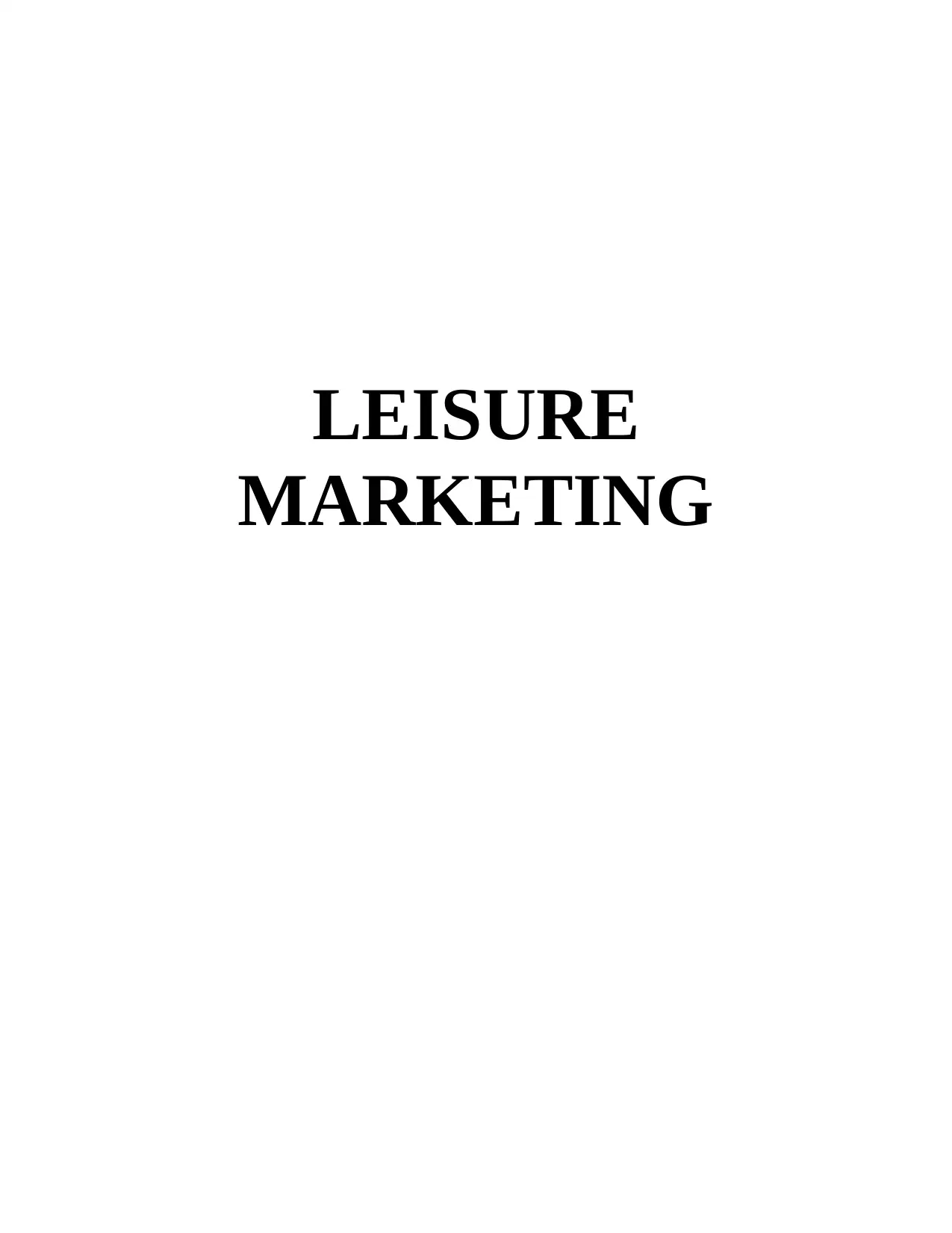
LEISURE
MARKETING
MARKETING
Secure Best Marks with AI Grader
Need help grading? Try our AI Grader for instant feedback on your assignments.
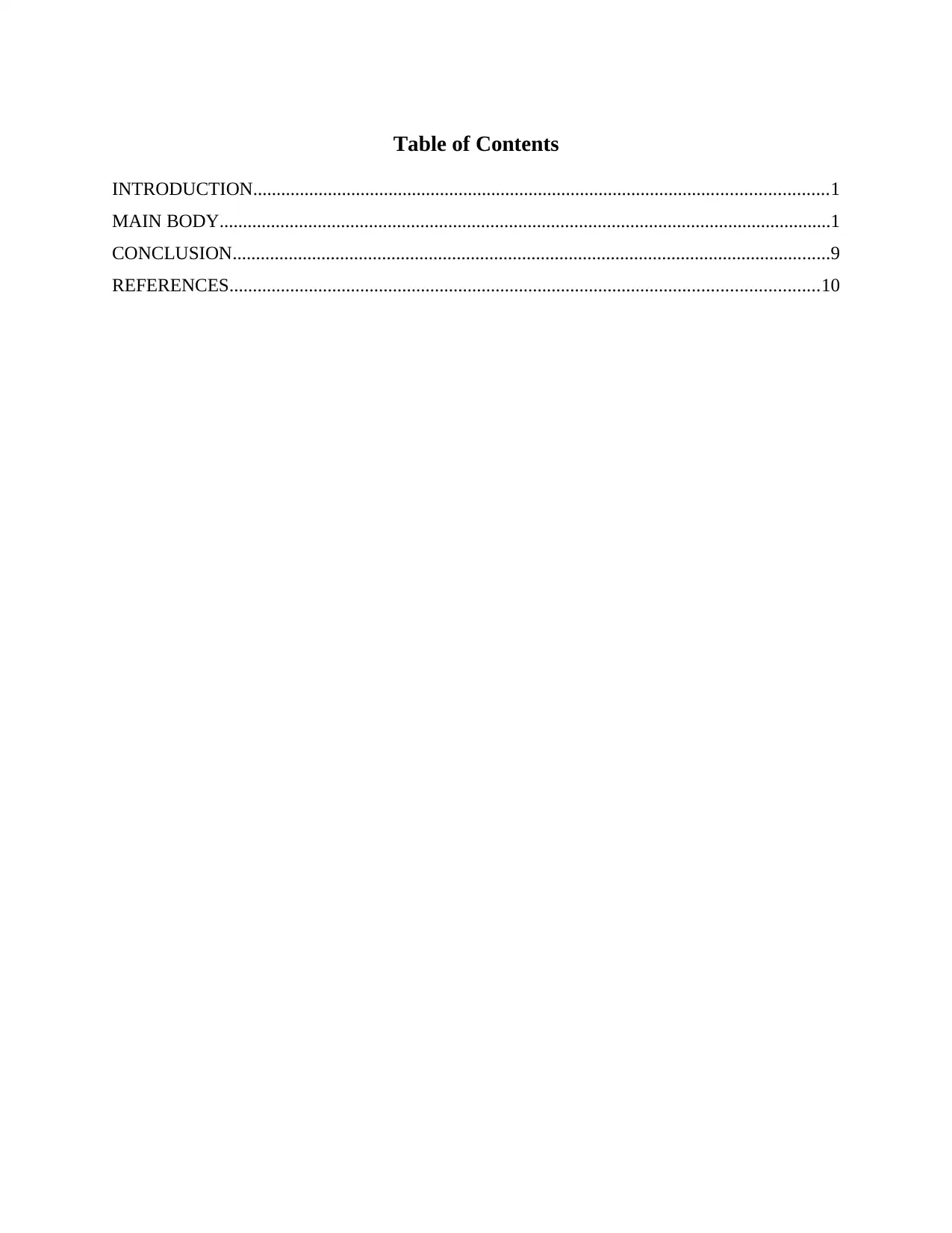
Table of Contents
INTRODUCTION...........................................................................................................................1
MAIN BODY...................................................................................................................................1
CONCLUSION................................................................................................................................9
REFERENCES..............................................................................................................................10
INTRODUCTION...........................................................................................................................1
MAIN BODY...................................................................................................................................1
CONCLUSION................................................................................................................................9
REFERENCES..............................................................................................................................10

INTRODUCTION
Leisure Marketing refers to an amalgamation of several appropriate and effective
marketing methods and processes, which marketers use in context of enhancing the familiarity of
different realms of leisure, along with several destinations (Štefko, Kiráľová and Mudrík, 2015).
In addition to this, such marketing is also inclusive of experience economy, which refers to the
shift in marketing of leisure and tourism activities from products and services, to customer
experiences. In this context, the essay below is based on Dimensions of Experiences. This covers
a critical exploration of four realms of customer experiences, particularly, entertainment,
educational, esthetic and escapist. Along with this, the report also covers how the experiences
within them are understood. Furthermore, the essay includes a deep discussion in relation to how
these several characteristics are integrated by marketers and developed while designing their
experiences.
MAIN BODY
Dimensions of Experiences
Customer experiences have evolved with time and so has the tourism sector globally.
Moreover, while the traditional aspect of tourism had been consistent with marketing
destinations and activities, marketers today have developed and shifter their focus upon several
dimensions of marketing while appropriately designing experiences of customer effectively.
The dimensions represent different motives, agendas and purpose of tourism for
individuals which develop their interests, as well as enthusiasm if marketers design these
dimensions as per the interests of customers. Moreover, doing so could be very much effective in
relation to developing and fostering prominent and appropriate experiences (Leung, Bai and
Stahura, 2015).
However, before designing their experiences, there is a prominent need in relation to
developing an understanding all the four realms and how the experiences could be understood
through them.
Experience Realms
All the realms reflected above engage customers across several dimensions. These
dimensions that have been appropriately proposed previously by theorists have a prominent
1
Leisure Marketing refers to an amalgamation of several appropriate and effective
marketing methods and processes, which marketers use in context of enhancing the familiarity of
different realms of leisure, along with several destinations (Štefko, Kiráľová and Mudrík, 2015).
In addition to this, such marketing is also inclusive of experience economy, which refers to the
shift in marketing of leisure and tourism activities from products and services, to customer
experiences. In this context, the essay below is based on Dimensions of Experiences. This covers
a critical exploration of four realms of customer experiences, particularly, entertainment,
educational, esthetic and escapist. Along with this, the report also covers how the experiences
within them are understood. Furthermore, the essay includes a deep discussion in relation to how
these several characteristics are integrated by marketers and developed while designing their
experiences.
MAIN BODY
Dimensions of Experiences
Customer experiences have evolved with time and so has the tourism sector globally.
Moreover, while the traditional aspect of tourism had been consistent with marketing
destinations and activities, marketers today have developed and shifter their focus upon several
dimensions of marketing while appropriately designing experiences of customer effectively.
The dimensions represent different motives, agendas and purpose of tourism for
individuals which develop their interests, as well as enthusiasm if marketers design these
dimensions as per the interests of customers. Moreover, doing so could be very much effective in
relation to developing and fostering prominent and appropriate experiences (Leung, Bai and
Stahura, 2015).
However, before designing their experiences, there is a prominent need in relation to
developing an understanding all the four realms and how the experiences could be understood
through them.
Experience Realms
All the realms reflected above engage customers across several dimensions. These
dimensions that have been appropriately proposed previously by theorists have a prominent
1
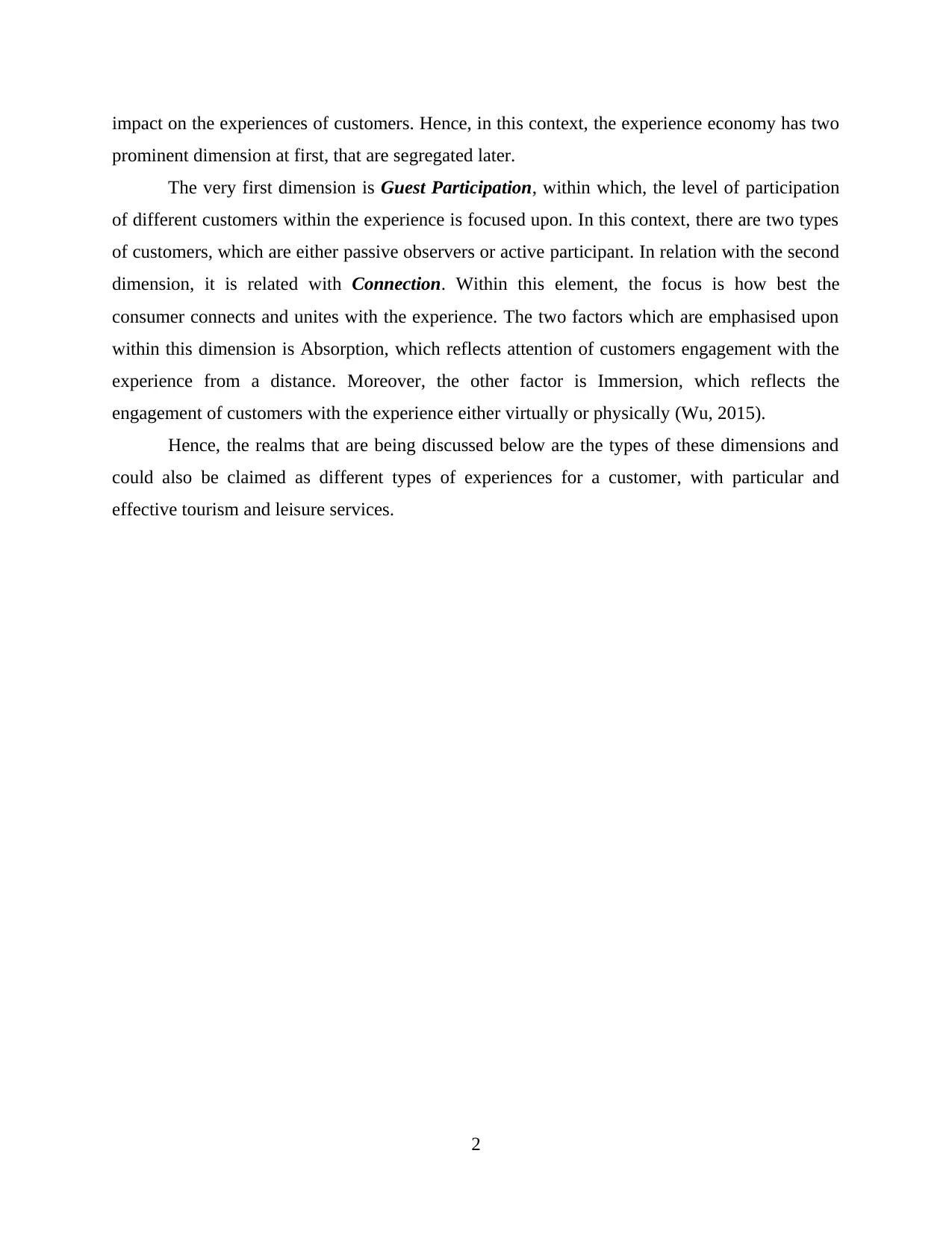
impact on the experiences of customers. Hence, in this context, the experience economy has two
prominent dimension at first, that are segregated later.
The very first dimension is Guest Participation, within which, the level of participation
of different customers within the experience is focused upon. In this context, there are two types
of customers, which are either passive observers or active participant. In relation with the second
dimension, it is related with Connection. Within this element, the focus is how best the
consumer connects and unites with the experience. The two factors which are emphasised upon
within this dimension is Absorption, which reflects attention of customers engagement with the
experience from a distance. Moreover, the other factor is Immersion, which reflects the
engagement of customers with the experience either virtually or physically (Wu, 2015).
Hence, the realms that are being discussed below are the types of these dimensions and
could also be claimed as different types of experiences for a customer, with particular and
effective tourism and leisure services.
2
prominent dimension at first, that are segregated later.
The very first dimension is Guest Participation, within which, the level of participation
of different customers within the experience is focused upon. In this context, there are two types
of customers, which are either passive observers or active participant. In relation with the second
dimension, it is related with Connection. Within this element, the focus is how best the
consumer connects and unites with the experience. The two factors which are emphasised upon
within this dimension is Absorption, which reflects attention of customers engagement with the
experience from a distance. Moreover, the other factor is Immersion, which reflects the
engagement of customers with the experience either virtually or physically (Wu, 2015).
Hence, the realms that are being discussed below are the types of these dimensions and
could also be claimed as different types of experiences for a customer, with particular and
effective tourism and leisure services.
2
Paraphrase This Document
Need a fresh take? Get an instant paraphrase of this document with our AI Paraphraser
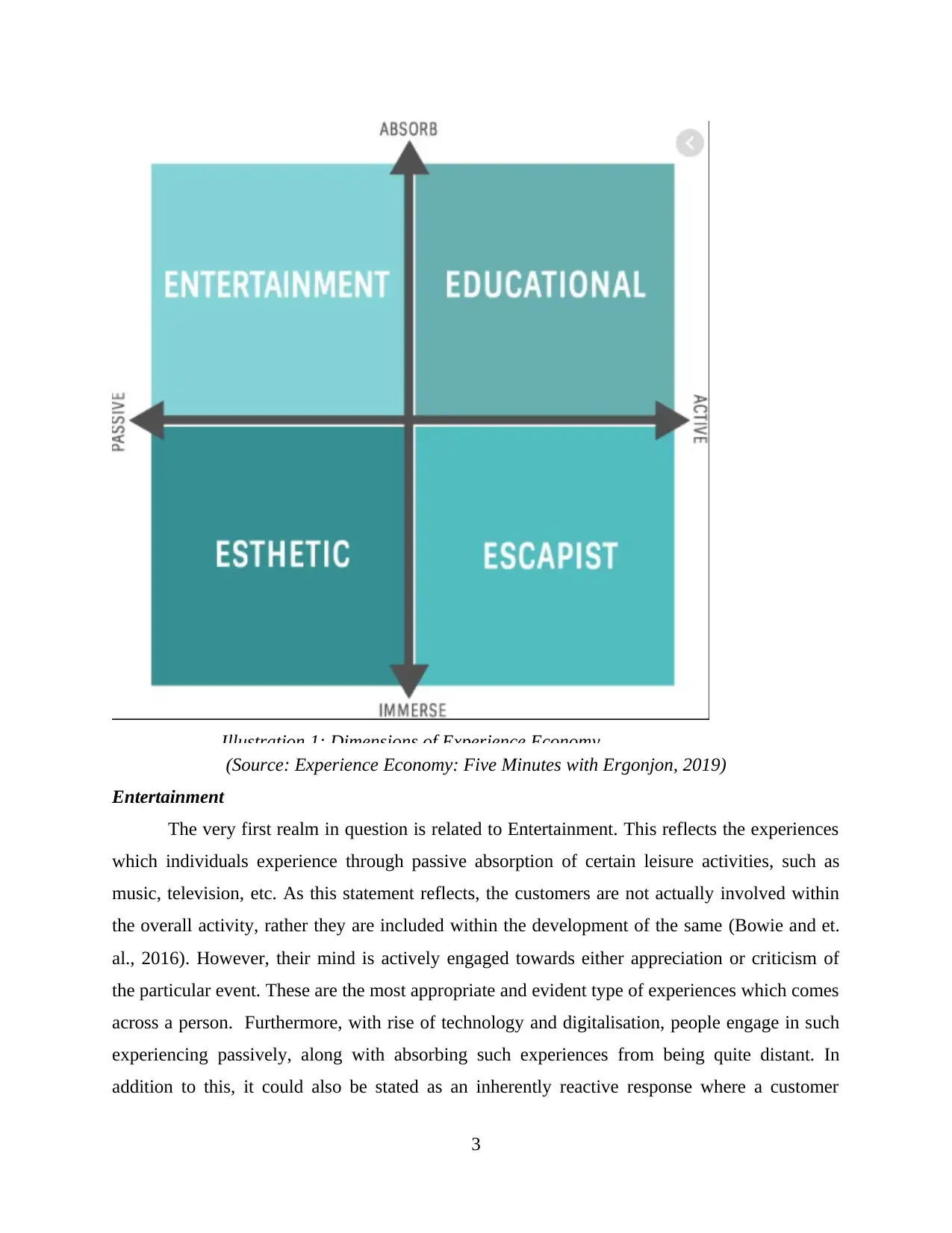
Illustration 1: Dimensions of Experience Economy
(Source: Experience Economy: Five Minutes with Ergonjon, 2019)
Entertainment
The very first realm in question is related to Entertainment. This reflects the experiences
which individuals experience through passive absorption of certain leisure activities, such as
music, television, etc. As this statement reflects, the customers are not actually involved within
the overall activity, rather they are included within the development of the same (Bowie and et.
al., 2016). However, their mind is actively engaged towards either appreciation or criticism of
the particular event. These are the most appropriate and evident type of experiences which comes
across a person. Furthermore, with rise of technology and digitalisation, people engage in such
experiencing passively, along with absorbing such experiences from being quite distant. In
addition to this, it could also be stated as an inherently reactive response where a customer
3
(Source: Experience Economy: Five Minutes with Ergonjon, 2019)
Entertainment
The very first realm in question is related to Entertainment. This reflects the experiences
which individuals experience through passive absorption of certain leisure activities, such as
music, television, etc. As this statement reflects, the customers are not actually involved within
the overall activity, rather they are included within the development of the same (Bowie and et.
al., 2016). However, their mind is actively engaged towards either appreciation or criticism of
the particular event. These are the most appropriate and evident type of experiences which comes
across a person. Furthermore, with rise of technology and digitalisation, people engage in such
experiencing passively, along with absorbing such experiences from being quite distant. In
addition to this, it could also be stated as an inherently reactive response where a customer
3
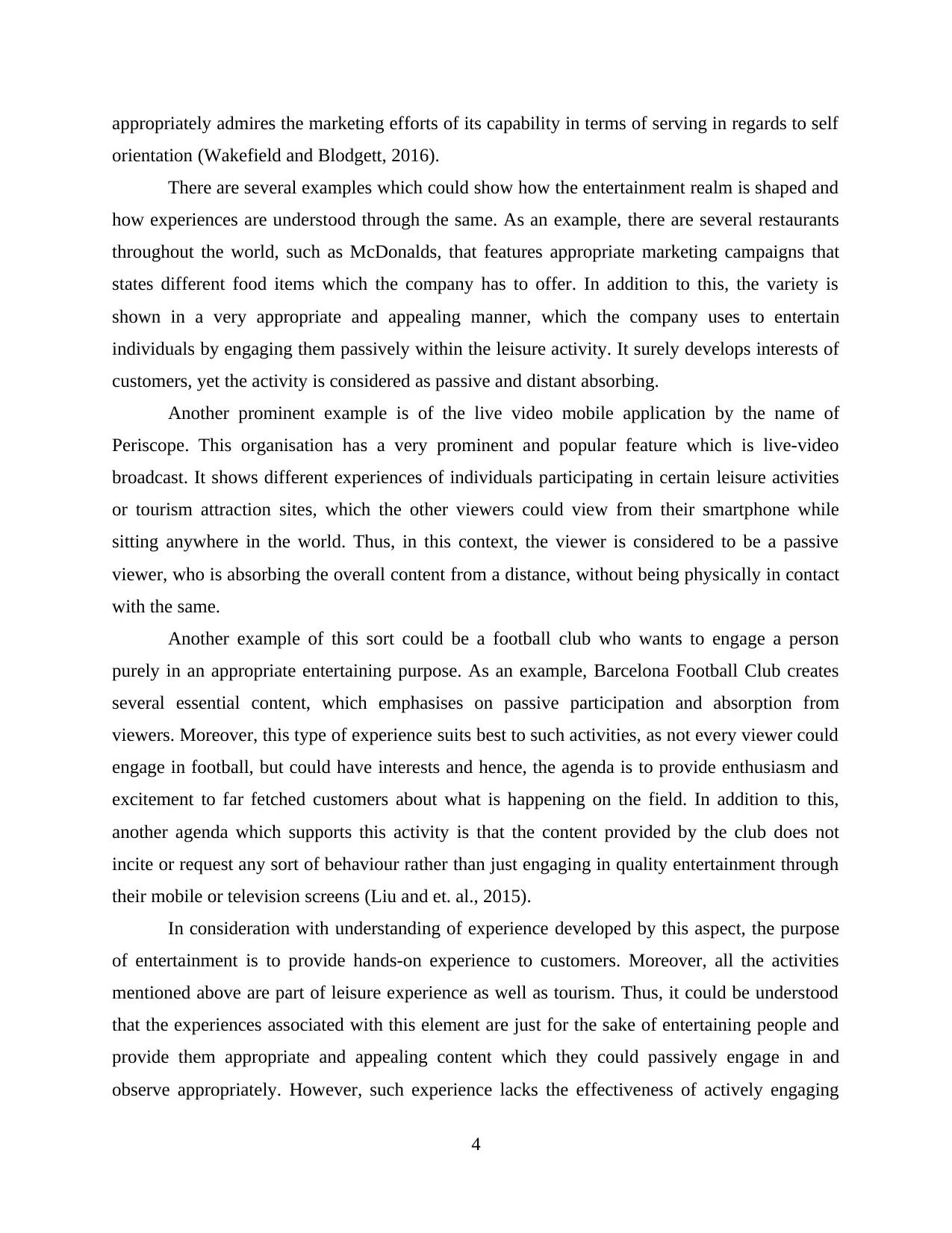
appropriately admires the marketing efforts of its capability in terms of serving in regards to self
orientation (Wakefield and Blodgett, 2016).
There are several examples which could show how the entertainment realm is shaped and
how experiences are understood through the same. As an example, there are several restaurants
throughout the world, such as McDonalds, that features appropriate marketing campaigns that
states different food items which the company has to offer. In addition to this, the variety is
shown in a very appropriate and appealing manner, which the company uses to entertain
individuals by engaging them passively within the leisure activity. It surely develops interests of
customers, yet the activity is considered as passive and distant absorbing.
Another prominent example is of the live video mobile application by the name of
Periscope. This organisation has a very prominent and popular feature which is live-video
broadcast. It shows different experiences of individuals participating in certain leisure activities
or tourism attraction sites, which the other viewers could view from their smartphone while
sitting anywhere in the world. Thus, in this context, the viewer is considered to be a passive
viewer, who is absorbing the overall content from a distance, without being physically in contact
with the same.
Another example of this sort could be a football club who wants to engage a person
purely in an appropriate entertaining purpose. As an example, Barcelona Football Club creates
several essential content, which emphasises on passive participation and absorption from
viewers. Moreover, this type of experience suits best to such activities, as not every viewer could
engage in football, but could have interests and hence, the agenda is to provide enthusiasm and
excitement to far fetched customers about what is happening on the field. In addition to this,
another agenda which supports this activity is that the content provided by the club does not
incite or request any sort of behaviour rather than just engaging in quality entertainment through
their mobile or television screens (Liu and et. al., 2015).
In consideration with understanding of experience developed by this aspect, the purpose
of entertainment is to provide hands-on experience to customers. Moreover, all the activities
mentioned above are part of leisure experience as well as tourism. Thus, it could be understood
that the experiences associated with this element are just for the sake of entertaining people and
provide them appropriate and appealing content which they could passively engage in and
observe appropriately. However, such experience lacks the effectiveness of actively engaging
4
orientation (Wakefield and Blodgett, 2016).
There are several examples which could show how the entertainment realm is shaped and
how experiences are understood through the same. As an example, there are several restaurants
throughout the world, such as McDonalds, that features appropriate marketing campaigns that
states different food items which the company has to offer. In addition to this, the variety is
shown in a very appropriate and appealing manner, which the company uses to entertain
individuals by engaging them passively within the leisure activity. It surely develops interests of
customers, yet the activity is considered as passive and distant absorbing.
Another prominent example is of the live video mobile application by the name of
Periscope. This organisation has a very prominent and popular feature which is live-video
broadcast. It shows different experiences of individuals participating in certain leisure activities
or tourism attraction sites, which the other viewers could view from their smartphone while
sitting anywhere in the world. Thus, in this context, the viewer is considered to be a passive
viewer, who is absorbing the overall content from a distance, without being physically in contact
with the same.
Another example of this sort could be a football club who wants to engage a person
purely in an appropriate entertaining purpose. As an example, Barcelona Football Club creates
several essential content, which emphasises on passive participation and absorption from
viewers. Moreover, this type of experience suits best to such activities, as not every viewer could
engage in football, but could have interests and hence, the agenda is to provide enthusiasm and
excitement to far fetched customers about what is happening on the field. In addition to this,
another agenda which supports this activity is that the content provided by the club does not
incite or request any sort of behaviour rather than just engaging in quality entertainment through
their mobile or television screens (Liu and et. al., 2015).
In consideration with understanding of experience developed by this aspect, the purpose
of entertainment is to provide hands-on experience to customers. Moreover, all the activities
mentioned above are part of leisure experience as well as tourism. Thus, it could be understood
that the experiences associated with this element are just for the sake of entertaining people and
provide them appropriate and appealing content which they could passively engage in and
observe appropriately. However, such experience lacks the effectiveness of actively engaging
4

customers, which risks in their disengagement quite easily, when they find some better source of
experience. Hence, exclusivity is quite missing from this experience.
Educational
Within this realm, active engagement of the experience is the purpose of leisure
activities. Moreover, the purpose of the same is to increase their knowledge appropriately.
Furthermore, the prime method through which the experience is usually created is through
interactive learning (Lehto, Park and Gordon, 2015).
There are several leisure activities which provide such educational experiences. For
example, attending a ski lesson or lessons for paragliding could be very well included within this
realm. However, it depends upon the group and their intention in relation to immerse in the
activity. As an instance, while the lessons mentioned above specifies and contains a window to
be actively engaged in the event, however, groups such as school children observe the same from
a distance, which makes the experience just for the sake of education. However, perceptions
differ when it comes to educational experiences. For instance, connection from a particular
activity is not necessary to be developed through physical contact only, but rather through
cognitive processes as well. For example, educational experience for skiing as mentioned above
could be well connected with children, if they have thought, understood, learnt as well as
remembered the whole process effectively. Hence, such debates have been long standing when it
comes to educational realm.
In relation to the same, the examples represent quite an appropriate and effective
approaches of how organisations providing tourism and leisure activities create educational
experiences for the customers. A prominent aspect reflecting the same could be by Barcelona
Football Club, which could provide live-video educational experiences to customers through
several mobile applications of via social media. This would help them in learning certain tricks
and tips associated with the game, which would make consumers feel more connected with the
sport and would help them in observing, yet engaging with the same effectively.
Another example associated with the same is also related to sports. British Broadcasting
Company (BBC) is one of the most acknowledged organisations within the UK. However, the
company is active in relation to appropriately and enhancing the active involvement of
individuals through their sports and fitness learning service (BBC: Online Learning, Sports and
Fitness, 2019). This provides an essential educational experience to the individual without being
5
experience. Hence, exclusivity is quite missing from this experience.
Educational
Within this realm, active engagement of the experience is the purpose of leisure
activities. Moreover, the purpose of the same is to increase their knowledge appropriately.
Furthermore, the prime method through which the experience is usually created is through
interactive learning (Lehto, Park and Gordon, 2015).
There are several leisure activities which provide such educational experiences. For
example, attending a ski lesson or lessons for paragliding could be very well included within this
realm. However, it depends upon the group and their intention in relation to immerse in the
activity. As an instance, while the lessons mentioned above specifies and contains a window to
be actively engaged in the event, however, groups such as school children observe the same from
a distance, which makes the experience just for the sake of education. However, perceptions
differ when it comes to educational experiences. For instance, connection from a particular
activity is not necessary to be developed through physical contact only, but rather through
cognitive processes as well. For example, educational experience for skiing as mentioned above
could be well connected with children, if they have thought, understood, learnt as well as
remembered the whole process effectively. Hence, such debates have been long standing when it
comes to educational realm.
In relation to the same, the examples represent quite an appropriate and effective
approaches of how organisations providing tourism and leisure activities create educational
experiences for the customers. A prominent aspect reflecting the same could be by Barcelona
Football Club, which could provide live-video educational experiences to customers through
several mobile applications of via social media. This would help them in learning certain tricks
and tips associated with the game, which would make consumers feel more connected with the
sport and would help them in observing, yet engaging with the same effectively.
Another example associated with the same is also related to sports. British Broadcasting
Company (BBC) is one of the most acknowledged organisations within the UK. However, the
company is active in relation to appropriately and enhancing the active involvement of
individuals through their sports and fitness learning service (BBC: Online Learning, Sports and
Fitness, 2019). This provides an essential educational experience to the individual without being
5
Secure Best Marks with AI Grader
Need help grading? Try our AI Grader for instant feedback on your assignments.
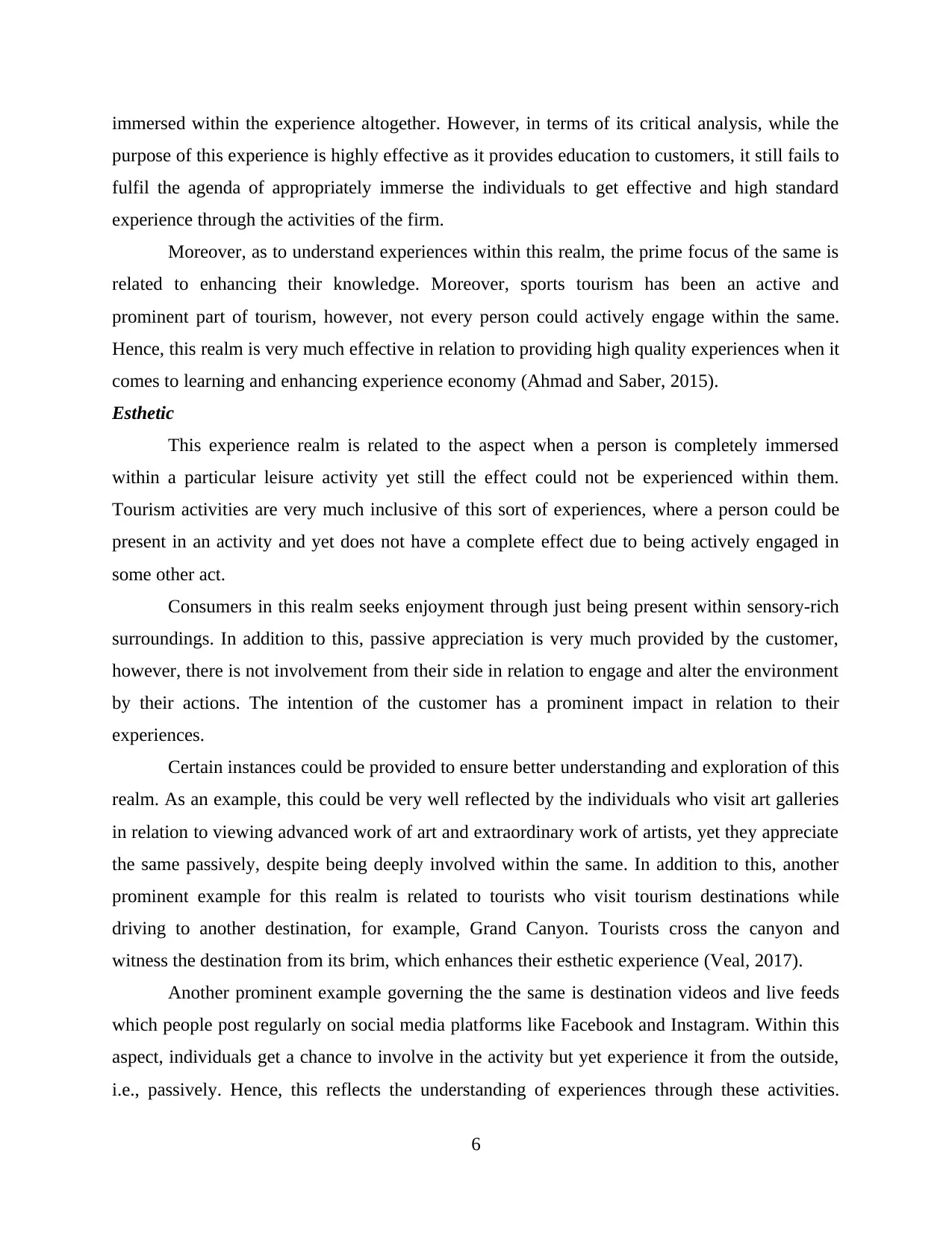
immersed within the experience altogether. However, in terms of its critical analysis, while the
purpose of this experience is highly effective as it provides education to customers, it still fails to
fulfil the agenda of appropriately immerse the individuals to get effective and high standard
experience through the activities of the firm.
Moreover, as to understand experiences within this realm, the prime focus of the same is
related to enhancing their knowledge. Moreover, sports tourism has been an active and
prominent part of tourism, however, not every person could actively engage within the same.
Hence, this realm is very much effective in relation to providing high quality experiences when it
comes to learning and enhancing experience economy (Ahmad and Saber, 2015).
Esthetic
This experience realm is related to the aspect when a person is completely immersed
within a particular leisure activity yet still the effect could not be experienced within them.
Tourism activities are very much inclusive of this sort of experiences, where a person could be
present in an activity and yet does not have a complete effect due to being actively engaged in
some other act.
Consumers in this realm seeks enjoyment through just being present within sensory-rich
surroundings. In addition to this, passive appreciation is very much provided by the customer,
however, there is not involvement from their side in relation to engage and alter the environment
by their actions. The intention of the customer has a prominent impact in relation to their
experiences.
Certain instances could be provided to ensure better understanding and exploration of this
realm. As an example, this could be very well reflected by the individuals who visit art galleries
in relation to viewing advanced work of art and extraordinary work of artists, yet they appreciate
the same passively, despite being deeply involved within the same. In addition to this, another
prominent example for this realm is related to tourists who visit tourism destinations while
driving to another destination, for example, Grand Canyon. Tourists cross the canyon and
witness the destination from its brim, which enhances their esthetic experience (Veal, 2017).
Another prominent example governing the the same is destination videos and live feeds
which people post regularly on social media platforms like Facebook and Instagram. Within this
aspect, individuals get a chance to involve in the activity but yet experience it from the outside,
i.e., passively. Hence, this reflects the understanding of experiences through these activities.
6
purpose of this experience is highly effective as it provides education to customers, it still fails to
fulfil the agenda of appropriately immerse the individuals to get effective and high standard
experience through the activities of the firm.
Moreover, as to understand experiences within this realm, the prime focus of the same is
related to enhancing their knowledge. Moreover, sports tourism has been an active and
prominent part of tourism, however, not every person could actively engage within the same.
Hence, this realm is very much effective in relation to providing high quality experiences when it
comes to learning and enhancing experience economy (Ahmad and Saber, 2015).
Esthetic
This experience realm is related to the aspect when a person is completely immersed
within a particular leisure activity yet still the effect could not be experienced within them.
Tourism activities are very much inclusive of this sort of experiences, where a person could be
present in an activity and yet does not have a complete effect due to being actively engaged in
some other act.
Consumers in this realm seeks enjoyment through just being present within sensory-rich
surroundings. In addition to this, passive appreciation is very much provided by the customer,
however, there is not involvement from their side in relation to engage and alter the environment
by their actions. The intention of the customer has a prominent impact in relation to their
experiences.
Certain instances could be provided to ensure better understanding and exploration of this
realm. As an example, this could be very well reflected by the individuals who visit art galleries
in relation to viewing advanced work of art and extraordinary work of artists, yet they appreciate
the same passively, despite being deeply involved within the same. In addition to this, another
prominent example for this realm is related to tourists who visit tourism destinations while
driving to another destination, for example, Grand Canyon. Tourists cross the canyon and
witness the destination from its brim, which enhances their esthetic experience (Veal, 2017).
Another prominent example governing the the same is destination videos and live feeds
which people post regularly on social media platforms like Facebook and Instagram. Within this
aspect, individuals get a chance to involve in the activity but yet experience it from the outside,
i.e., passively. Hence, this reflects the understanding of experiences through these activities.
6
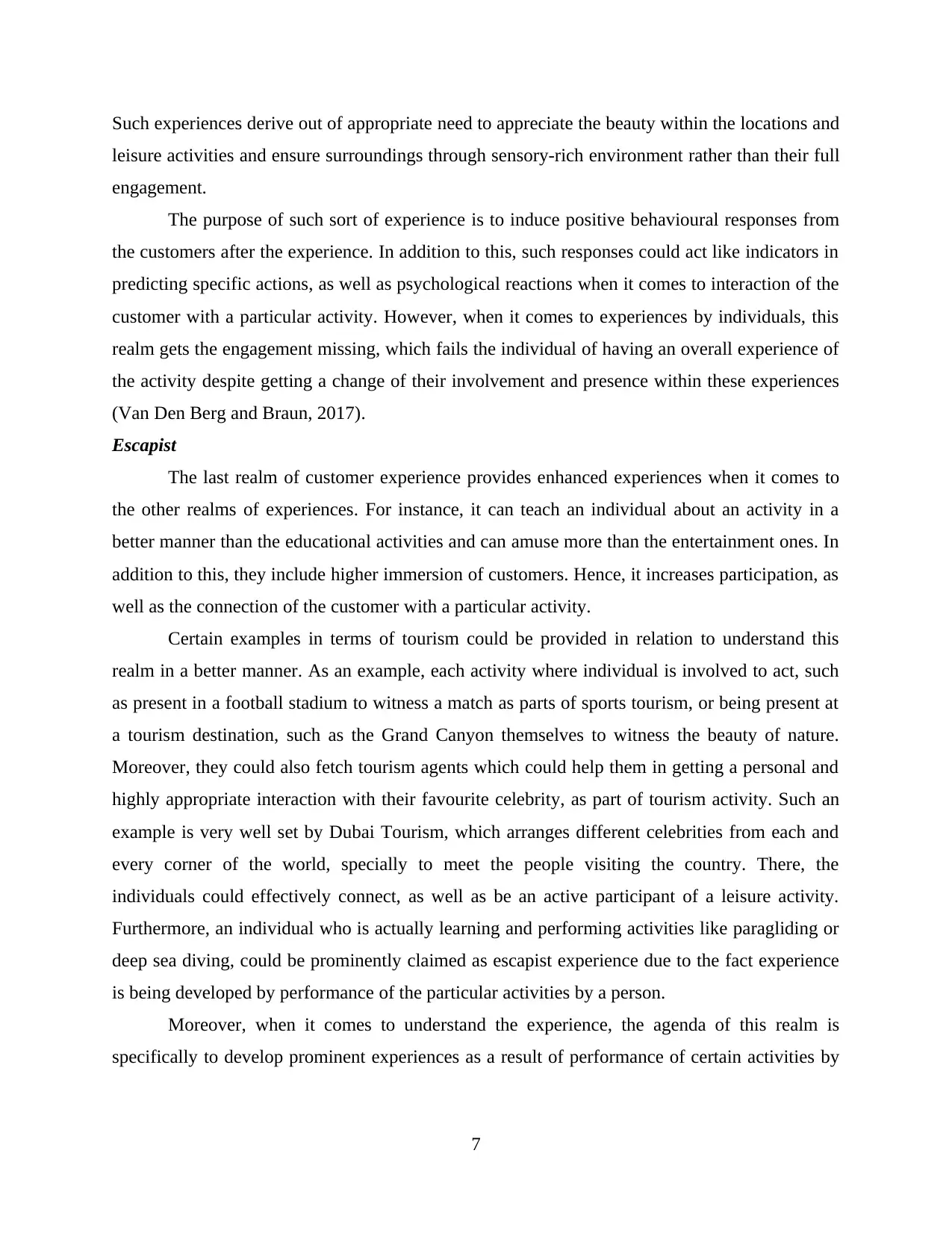
Such experiences derive out of appropriate need to appreciate the beauty within the locations and
leisure activities and ensure surroundings through sensory-rich environment rather than their full
engagement.
The purpose of such sort of experience is to induce positive behavioural responses from
the customers after the experience. In addition to this, such responses could act like indicators in
predicting specific actions, as well as psychological reactions when it comes to interaction of the
customer with a particular activity. However, when it comes to experiences by individuals, this
realm gets the engagement missing, which fails the individual of having an overall experience of
the activity despite getting a change of their involvement and presence within these experiences
(Van Den Berg and Braun, 2017).
Escapist
The last realm of customer experience provides enhanced experiences when it comes to
the other realms of experiences. For instance, it can teach an individual about an activity in a
better manner than the educational activities and can amuse more than the entertainment ones. In
addition to this, they include higher immersion of customers. Hence, it increases participation, as
well as the connection of the customer with a particular activity.
Certain examples in terms of tourism could be provided in relation to understand this
realm in a better manner. As an example, each activity where individual is involved to act, such
as present in a football stadium to witness a match as parts of sports tourism, or being present at
a tourism destination, such as the Grand Canyon themselves to witness the beauty of nature.
Moreover, they could also fetch tourism agents which could help them in getting a personal and
highly appropriate interaction with their favourite celebrity, as part of tourism activity. Such an
example is very well set by Dubai Tourism, which arranges different celebrities from each and
every corner of the world, specially to meet the people visiting the country. There, the
individuals could effectively connect, as well as be an active participant of a leisure activity.
Furthermore, an individual who is actually learning and performing activities like paragliding or
deep sea diving, could be prominently claimed as escapist experience due to the fact experience
is being developed by performance of the particular activities by a person.
Moreover, when it comes to understand the experience, the agenda of this realm is
specifically to develop prominent experiences as a result of performance of certain activities by
7
leisure activities and ensure surroundings through sensory-rich environment rather than their full
engagement.
The purpose of such sort of experience is to induce positive behavioural responses from
the customers after the experience. In addition to this, such responses could act like indicators in
predicting specific actions, as well as psychological reactions when it comes to interaction of the
customer with a particular activity. However, when it comes to experiences by individuals, this
realm gets the engagement missing, which fails the individual of having an overall experience of
the activity despite getting a change of their involvement and presence within these experiences
(Van Den Berg and Braun, 2017).
Escapist
The last realm of customer experience provides enhanced experiences when it comes to
the other realms of experiences. For instance, it can teach an individual about an activity in a
better manner than the educational activities and can amuse more than the entertainment ones. In
addition to this, they include higher immersion of customers. Hence, it increases participation, as
well as the connection of the customer with a particular activity.
Certain examples in terms of tourism could be provided in relation to understand this
realm in a better manner. As an example, each activity where individual is involved to act, such
as present in a football stadium to witness a match as parts of sports tourism, or being present at
a tourism destination, such as the Grand Canyon themselves to witness the beauty of nature.
Moreover, they could also fetch tourism agents which could help them in getting a personal and
highly appropriate interaction with their favourite celebrity, as part of tourism activity. Such an
example is very well set by Dubai Tourism, which arranges different celebrities from each and
every corner of the world, specially to meet the people visiting the country. There, the
individuals could effectively connect, as well as be an active participant of a leisure activity.
Furthermore, an individual who is actually learning and performing activities like paragliding or
deep sea diving, could be prominently claimed as escapist experience due to the fact experience
is being developed by performance of the particular activities by a person.
Moreover, when it comes to understand the experience, the agenda of this realm is
specifically to develop prominent experiences as a result of performance of certain activities by
7
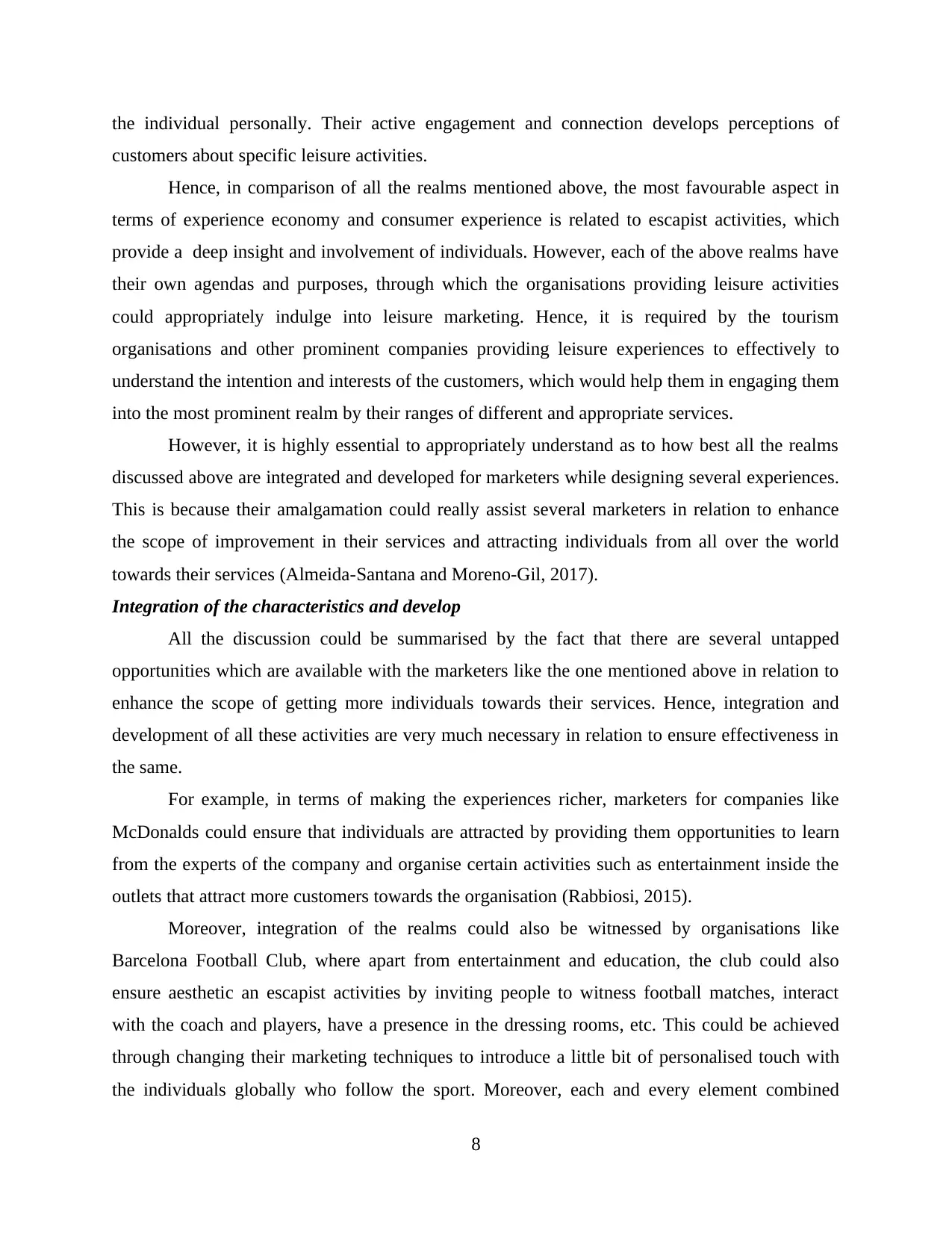
the individual personally. Their active engagement and connection develops perceptions of
customers about specific leisure activities.
Hence, in comparison of all the realms mentioned above, the most favourable aspect in
terms of experience economy and consumer experience is related to escapist activities, which
provide a deep insight and involvement of individuals. However, each of the above realms have
their own agendas and purposes, through which the organisations providing leisure activities
could appropriately indulge into leisure marketing. Hence, it is required by the tourism
organisations and other prominent companies providing leisure experiences to effectively to
understand the intention and interests of the customers, which would help them in engaging them
into the most prominent realm by their ranges of different and appropriate services.
However, it is highly essential to appropriately understand as to how best all the realms
discussed above are integrated and developed for marketers while designing several experiences.
This is because their amalgamation could really assist several marketers in relation to enhance
the scope of improvement in their services and attracting individuals from all over the world
towards their services (Almeida-Santana and Moreno-Gil, 2017).
Integration of the characteristics and develop
All the discussion could be summarised by the fact that there are several untapped
opportunities which are available with the marketers like the one mentioned above in relation to
enhance the scope of getting more individuals towards their services. Hence, integration and
development of all these activities are very much necessary in relation to ensure effectiveness in
the same.
For example, in terms of making the experiences richer, marketers for companies like
McDonalds could ensure that individuals are attracted by providing them opportunities to learn
from the experts of the company and organise certain activities such as entertainment inside the
outlets that attract more customers towards the organisation (Rabbiosi, 2015).
Moreover, integration of the realms could also be witnessed by organisations like
Barcelona Football Club, where apart from entertainment and education, the club could also
ensure aesthetic an escapist activities by inviting people to witness football matches, interact
with the coach and players, have a presence in the dressing rooms, etc. This could be achieved
through changing their marketing techniques to introduce a little bit of personalised touch with
the individuals globally who follow the sport. Moreover, each and every element combined
8
customers about specific leisure activities.
Hence, in comparison of all the realms mentioned above, the most favourable aspect in
terms of experience economy and consumer experience is related to escapist activities, which
provide a deep insight and involvement of individuals. However, each of the above realms have
their own agendas and purposes, through which the organisations providing leisure activities
could appropriately indulge into leisure marketing. Hence, it is required by the tourism
organisations and other prominent companies providing leisure experiences to effectively to
understand the intention and interests of the customers, which would help them in engaging them
into the most prominent realm by their ranges of different and appropriate services.
However, it is highly essential to appropriately understand as to how best all the realms
discussed above are integrated and developed for marketers while designing several experiences.
This is because their amalgamation could really assist several marketers in relation to enhance
the scope of improvement in their services and attracting individuals from all over the world
towards their services (Almeida-Santana and Moreno-Gil, 2017).
Integration of the characteristics and develop
All the discussion could be summarised by the fact that there are several untapped
opportunities which are available with the marketers like the one mentioned above in relation to
enhance the scope of getting more individuals towards their services. Hence, integration and
development of all these activities are very much necessary in relation to ensure effectiveness in
the same.
For example, in terms of making the experiences richer, marketers for companies like
McDonalds could ensure that individuals are attracted by providing them opportunities to learn
from the experts of the company and organise certain activities such as entertainment inside the
outlets that attract more customers towards the organisation (Rabbiosi, 2015).
Moreover, integration of the realms could also be witnessed by organisations like
Barcelona Football Club, where apart from entertainment and education, the club could also
ensure aesthetic an escapist activities by inviting people to witness football matches, interact
with the coach and players, have a presence in the dressing rooms, etc. This could be achieved
through changing their marketing techniques to introduce a little bit of personalised touch with
the individuals globally who follow the sport. Moreover, each and every element combined
8
Paraphrase This Document
Need a fresh take? Get an instant paraphrase of this document with our AI Paraphraser
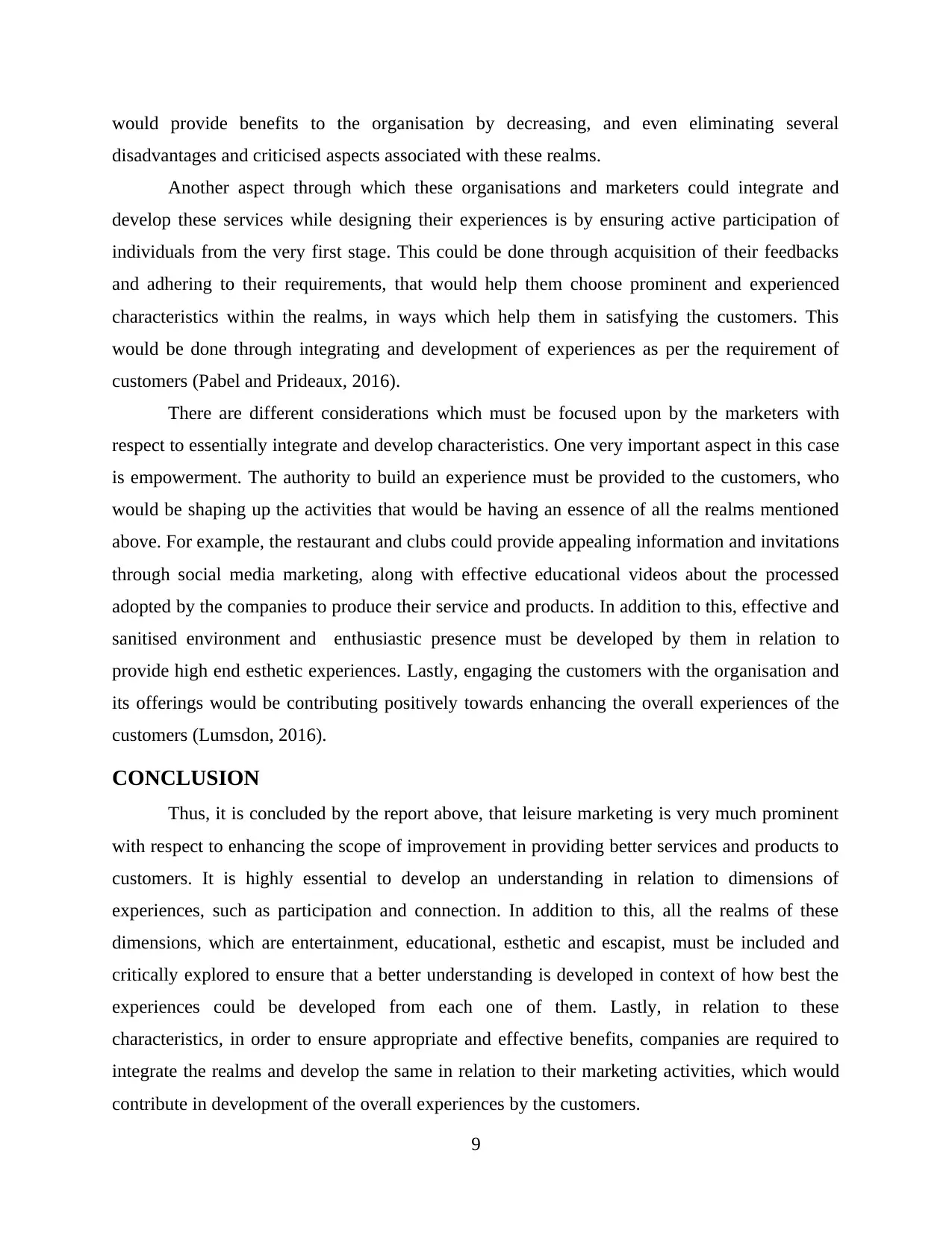
would provide benefits to the organisation by decreasing, and even eliminating several
disadvantages and criticised aspects associated with these realms.
Another aspect through which these organisations and marketers could integrate and
develop these services while designing their experiences is by ensuring active participation of
individuals from the very first stage. This could be done through acquisition of their feedbacks
and adhering to their requirements, that would help them choose prominent and experienced
characteristics within the realms, in ways which help them in satisfying the customers. This
would be done through integrating and development of experiences as per the requirement of
customers (Pabel and Prideaux, 2016).
There are different considerations which must be focused upon by the marketers with
respect to essentially integrate and develop characteristics. One very important aspect in this case
is empowerment. The authority to build an experience must be provided to the customers, who
would be shaping up the activities that would be having an essence of all the realms mentioned
above. For example, the restaurant and clubs could provide appealing information and invitations
through social media marketing, along with effective educational videos about the processed
adopted by the companies to produce their service and products. In addition to this, effective and
sanitised environment and enthusiastic presence must be developed by them in relation to
provide high end esthetic experiences. Lastly, engaging the customers with the organisation and
its offerings would be contributing positively towards enhancing the overall experiences of the
customers (Lumsdon, 2016).
CONCLUSION
Thus, it is concluded by the report above, that leisure marketing is very much prominent
with respect to enhancing the scope of improvement in providing better services and products to
customers. It is highly essential to develop an understanding in relation to dimensions of
experiences, such as participation and connection. In addition to this, all the realms of these
dimensions, which are entertainment, educational, esthetic and escapist, must be included and
critically explored to ensure that a better understanding is developed in context of how best the
experiences could be developed from each one of them. Lastly, in relation to these
characteristics, in order to ensure appropriate and effective benefits, companies are required to
integrate the realms and develop the same in relation to their marketing activities, which would
contribute in development of the overall experiences by the customers.
9
disadvantages and criticised aspects associated with these realms.
Another aspect through which these organisations and marketers could integrate and
develop these services while designing their experiences is by ensuring active participation of
individuals from the very first stage. This could be done through acquisition of their feedbacks
and adhering to their requirements, that would help them choose prominent and experienced
characteristics within the realms, in ways which help them in satisfying the customers. This
would be done through integrating and development of experiences as per the requirement of
customers (Pabel and Prideaux, 2016).
There are different considerations which must be focused upon by the marketers with
respect to essentially integrate and develop characteristics. One very important aspect in this case
is empowerment. The authority to build an experience must be provided to the customers, who
would be shaping up the activities that would be having an essence of all the realms mentioned
above. For example, the restaurant and clubs could provide appealing information and invitations
through social media marketing, along with effective educational videos about the processed
adopted by the companies to produce their service and products. In addition to this, effective and
sanitised environment and enthusiastic presence must be developed by them in relation to
provide high end esthetic experiences. Lastly, engaging the customers with the organisation and
its offerings would be contributing positively towards enhancing the overall experiences of the
customers (Lumsdon, 2016).
CONCLUSION
Thus, it is concluded by the report above, that leisure marketing is very much prominent
with respect to enhancing the scope of improvement in providing better services and products to
customers. It is highly essential to develop an understanding in relation to dimensions of
experiences, such as participation and connection. In addition to this, all the realms of these
dimensions, which are entertainment, educational, esthetic and escapist, must be included and
critically explored to ensure that a better understanding is developed in context of how best the
experiences could be developed from each one of them. Lastly, in relation to these
characteristics, in order to ensure appropriate and effective benefits, companies are required to
integrate the realms and develop the same in relation to their marketing activities, which would
contribute in development of the overall experiences by the customers.
9
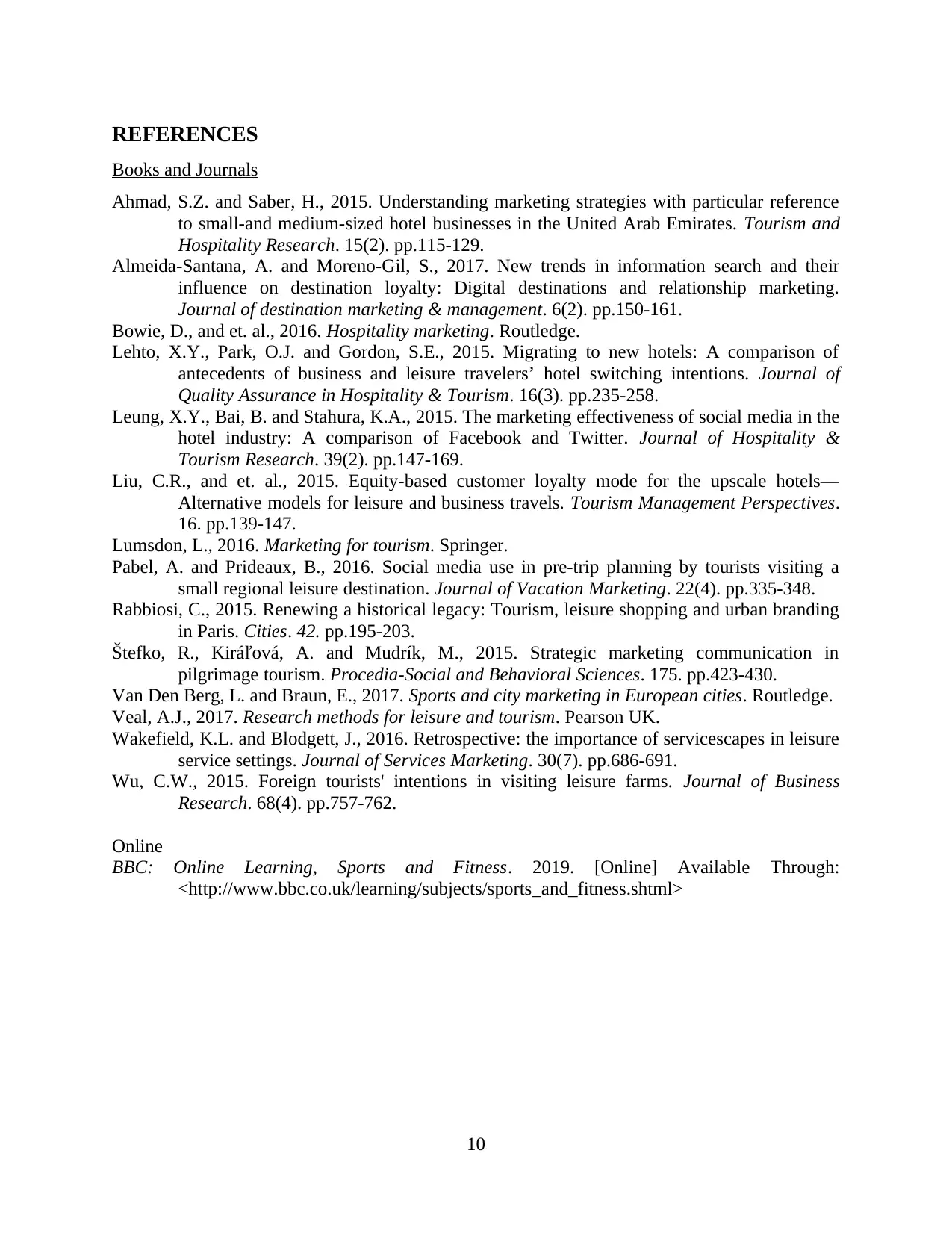
REFERENCES
Books and Journals
Ahmad, S.Z. and Saber, H., 2015. Understanding marketing strategies with particular reference
to small-and medium-sized hotel businesses in the United Arab Emirates. Tourism and
Hospitality Research. 15(2). pp.115-129.
Almeida-Santana, A. and Moreno-Gil, S., 2017. New trends in information search and their
influence on destination loyalty: Digital destinations and relationship marketing.
Journal of destination marketing & management. 6(2). pp.150-161.
Bowie, D., and et. al., 2016. Hospitality marketing. Routledge.
Lehto, X.Y., Park, O.J. and Gordon, S.E., 2015. Migrating to new hotels: A comparison of
antecedents of business and leisure travelers’ hotel switching intentions. Journal of
Quality Assurance in Hospitality & Tourism. 16(3). pp.235-258.
Leung, X.Y., Bai, B. and Stahura, K.A., 2015. The marketing effectiveness of social media in the
hotel industry: A comparison of Facebook and Twitter. Journal of Hospitality &
Tourism Research. 39(2). pp.147-169.
Liu, C.R., and et. al., 2015. Equity-based customer loyalty mode for the upscale hotels—
Alternative models for leisure and business travels. Tourism Management Perspectives.
16. pp.139-147.
Lumsdon, L., 2016. Marketing for tourism. Springer.
Pabel, A. and Prideaux, B., 2016. Social media use in pre-trip planning by tourists visiting a
small regional leisure destination. Journal of Vacation Marketing. 22(4). pp.335-348.
Rabbiosi, C., 2015. Renewing a historical legacy: Tourism, leisure shopping and urban branding
in Paris. Cities. 42. pp.195-203.
Štefko, R., Kiráľová, A. and Mudrík, M., 2015. Strategic marketing communication in
pilgrimage tourism. Procedia-Social and Behavioral Sciences. 175. pp.423-430.
Van Den Berg, L. and Braun, E., 2017. Sports and city marketing in European cities. Routledge.
Veal, A.J., 2017. Research methods for leisure and tourism. Pearson UK.
Wakefield, K.L. and Blodgett, J., 2016. Retrospective: the importance of servicescapes in leisure
service settings. Journal of Services Marketing. 30(7). pp.686-691.
Wu, C.W., 2015. Foreign tourists' intentions in visiting leisure farms. Journal of Business
Research. 68(4). pp.757-762.
Online
BBC: Online Learning, Sports and Fitness. 2019. [Online] Available Through:
<http://www.bbc.co.uk/learning/subjects/sports_and_fitness.shtml>
10
Books and Journals
Ahmad, S.Z. and Saber, H., 2015. Understanding marketing strategies with particular reference
to small-and medium-sized hotel businesses in the United Arab Emirates. Tourism and
Hospitality Research. 15(2). pp.115-129.
Almeida-Santana, A. and Moreno-Gil, S., 2017. New trends in information search and their
influence on destination loyalty: Digital destinations and relationship marketing.
Journal of destination marketing & management. 6(2). pp.150-161.
Bowie, D., and et. al., 2016. Hospitality marketing. Routledge.
Lehto, X.Y., Park, O.J. and Gordon, S.E., 2015. Migrating to new hotels: A comparison of
antecedents of business and leisure travelers’ hotel switching intentions. Journal of
Quality Assurance in Hospitality & Tourism. 16(3). pp.235-258.
Leung, X.Y., Bai, B. and Stahura, K.A., 2015. The marketing effectiveness of social media in the
hotel industry: A comparison of Facebook and Twitter. Journal of Hospitality &
Tourism Research. 39(2). pp.147-169.
Liu, C.R., and et. al., 2015. Equity-based customer loyalty mode for the upscale hotels—
Alternative models for leisure and business travels. Tourism Management Perspectives.
16. pp.139-147.
Lumsdon, L., 2016. Marketing for tourism. Springer.
Pabel, A. and Prideaux, B., 2016. Social media use in pre-trip planning by tourists visiting a
small regional leisure destination. Journal of Vacation Marketing. 22(4). pp.335-348.
Rabbiosi, C., 2015. Renewing a historical legacy: Tourism, leisure shopping and urban branding
in Paris. Cities. 42. pp.195-203.
Štefko, R., Kiráľová, A. and Mudrík, M., 2015. Strategic marketing communication in
pilgrimage tourism. Procedia-Social and Behavioral Sciences. 175. pp.423-430.
Van Den Berg, L. and Braun, E., 2017. Sports and city marketing in European cities. Routledge.
Veal, A.J., 2017. Research methods for leisure and tourism. Pearson UK.
Wakefield, K.L. and Blodgett, J., 2016. Retrospective: the importance of servicescapes in leisure
service settings. Journal of Services Marketing. 30(7). pp.686-691.
Wu, C.W., 2015. Foreign tourists' intentions in visiting leisure farms. Journal of Business
Research. 68(4). pp.757-762.
Online
BBC: Online Learning, Sports and Fitness. 2019. [Online] Available Through:
<http://www.bbc.co.uk/learning/subjects/sports_and_fitness.shtml>
10
1 out of 12
Related Documents
Your All-in-One AI-Powered Toolkit for Academic Success.
+13062052269
info@desklib.com
Available 24*7 on WhatsApp / Email
![[object Object]](/_next/static/media/star-bottom.7253800d.svg)
Unlock your academic potential
© 2024 | Zucol Services PVT LTD | All rights reserved.




